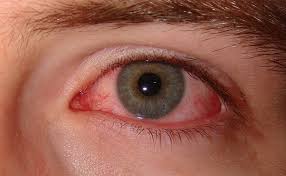
Dry Eye Syndrome: Understanding the Discomfort
Introduction:
Welcome to my blog, where I, Dr Ashesh Gala, a Senior Ophthalmologist at Netrajyot Eye Care Centre in Mulund, Mumbai, delve into the topic of dry eye syndrome.
Living with dry eyes syndrome doesn’t have to be a constant struggle.
By implementing the right strategies, you can alleviate discomfort and enhance your eye comfort.
In this article, we’ll explore the ins and outs of this common eye condition that can cause discomfort and impact your daily life.
Overview of Dry Eye Syndrome
Dry eye syndrome, also known as dry eye disease, occurs when your eyes don’t produce enough tears or the tears evaporate too quickly.
This leads to irritation, redness, and a gritty feeling in the eye. Understanding dry eyes syndrome empowers you to take control of your eye health.
By practising prevention strategies and seeking timely medical assistance, you can enjoy clear, comfortable vision.
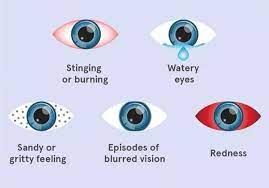
Symptoms of Dry Eye
- Persistent Dryness: Feeling like there’s something in your eye, even though it’s not visible.
- Scratchy Sensation: A constant itchiness or a sensation of a foreign body in the eye.
- Burning or Stinging: Eyes may feel like they’re on fire or have been exposed to irritants.
- Redness: Bloodshot eye due to inflammation and irritation.
- Light Sensitivity: Discomfort when exposed to bright lights.
- Watery Eye: Paradoxically, dry eye can trigger excessive tearing as a reflex response.
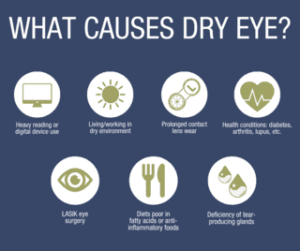
Causes of Dry Eye
- Age-Related Changes: Tear production decreases as we age.
- Environmental Factors: Wind, dry air, and air conditioning can contribute to dryness.
- Medical Conditions: Conditions like diabetes, autoimmune disorders, and thyroid problems.
- Medications: Antihistamines, decongestants, and certain blood pressure medications can reduce tear production.
- Prolonged Screen Time: Focusing on screens reduces blinking, leading to dryness.
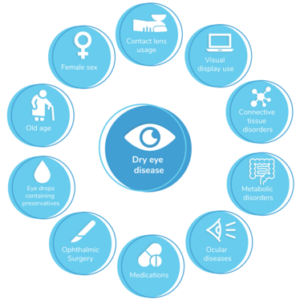
Risk Factors of Dry Eye
- Ageing: As mentioned, tear production decreases with age.
- Gender: Women are more likely to experience dry eye due to hormonal changes.
- Medical History: If you have diabetes, lupus, rheumatoid arthritis, or Sjögren’s syndrome, your risk is higher.
- Contact Lens Wear: Contact lenses can lead to dryness, especially if not cared for properly.
- Medications: Some medications decrease tear production, increasing the risk of dry eye.
Complications of Dry Eye Syndrome
Untreated dry eye syndrome can lead to several complications, including:
- Corneal Damage: Dryness can lead to abrasions on the cornea, the clear front surface of the eye.
- Eye Infections: Lack of proper lubrication can make the eye more susceptible to infections.
- Impaired Vision: Severe dry eye can cause blurred or fluctuating vision, impacting daily tasks.
Preventions of Dry Eye Syndrome

1. Stay Hydrated: Drinking plenty of water supports overall hydration, including your eyes. Prioritize hydration by drinking enough water and using a humidifier to maintain moist indoor air.

2. Blink Regularly: Remind yourself to blink frequently, especially during screen time.

3. Humidify Your Environment: Use a humidifier to add moisture to indoor air.

4. Omega-3 Fatty Acids: Include foods rich in omega-3s, like fish and flaxseeds, in your diet.

5. Limit Screen Time: Take breaks to rest your eyes while using digital devices.
Diagnosis of Dry Eye Syndrome
Diagnosing dry eye involves a comprehensive eye examination, including:
- Evaluating Tear Production: Measuring the quantity of tears your eyes produce.
- Assessing Tear Quality: Evaluating the composition of tears for proper lubrication.
- Checking the Corneal Surface: Examining the cornea for signs of damage or dry spots.
Treatment of Dry Eye Syndrome
Managing dry eye syndrome involves a multi-faceted approach tailored to your condition. Your ophthalmologist will recommend a tailored treatment plan, which may include medications, self-care practices, and lifestyle adjustments.
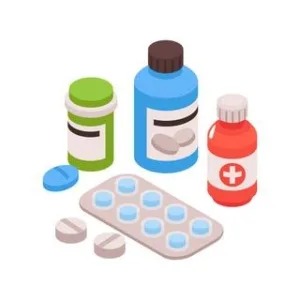
Medications-
- Artificial Tears: Over-the-counter eye drops that mimic natural tears for lubrication.
- Prescription Eye Drops: Medications that reduce inflammation and improve tear production.
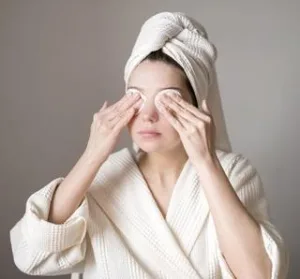
Self-Care-
- Warm Compresses: Applying warm compresses to your closed eyelids can help unblock tear glands.
- Blinking Exercises: Practice consciously blinking to distribute tears evenly across your eyes.
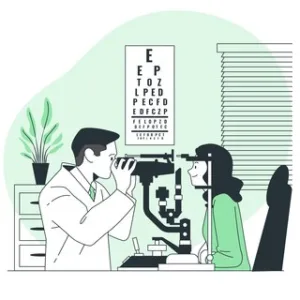
Finding the Right Ophthalmologist-
Choose an experienced ophthalmologist who specializes in dry eye syndrome for accurate diagnosis and personalized treatment.
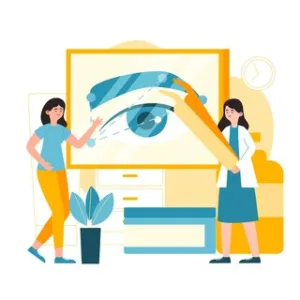
Personalized Approach to Dry Eye Syndrome Management
Every individual’s experience with dry eyes is unique. Consult an ophthalmologist to create a personalized plan for effective management.
Managing dry eyes syndrome is a journey that requires your proactive engagement.
With proper care, you can achieve greater eye comfort and well-being.
Stay connected with my blog for more insights into various eye conditions and their management.
Your active involvement in your eye health can make a significant impact on your overall quality of life.
Conclusion-
Dry eye syndrome can be uncomfortable, but understanding its causes, symptoms, and prevention strategies can help you manage the condition effectively. If you’re experiencing persistent discomfort, consult an ophthalmologist for proper diagnosis and guidance. Dry eye syndrome is a common condition that can affect anyone, but with the right knowledge and proactive measures, you can manage it effectively. Remember, your eye comfort matters, so prioritize your eye health and embrace a more comfortable future.
Have you noticed any symptoms of dry eye? What strategies do you use to keep your eye comfortable? Share your thoughts below.

